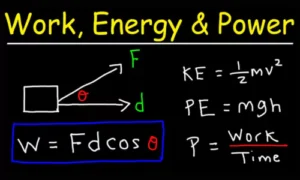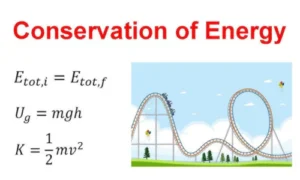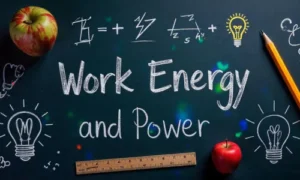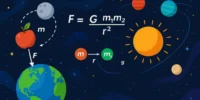In physics, work, power & energy are key notions that define how forces interact with objects, how energy is stored or transferred, and how activities are completed efficiently. From lifting a book to operating a machine, these rules control practically every aspect of daily life. Understanding them not only broadens your knowledge of physics but also allows you to appreciate how nature and technology interact.
What is Work?

In physics, work is done when a force is applied to an object and the object is displaced in the direction of the force.
- Formula: Work(W)=Force(F)×Displacement(d)×cosθ
Where:
- F = applied force
- d = displacement of the object
- θ = angle between force and displacement
Example: Pushing a cart forward involves doing work, but holding a heavy object without moving it does not (since there is no displacement).
What is Power?
Power refers to the rate at which work is done. It measures how quickly energy is transferred or converted.
Formula: Power(P)=Time(t)Work(W)
Example: If two people lift the same weight to the same height, but one does it faster, that person has used more power.
What is Energy?

Energy is the capacity to do work. It exists in many forms—mechanical, heat, light, chemical, etc. The two most important mechanical forms are kinetic energy and potential energy.
1. Kinetic Energy (KE)
The energy possessed by a body due to its motion.
Formula: KE=1/2 mv2
Where m = mass and v = velocity of the object.
Example: A moving car or a rolling ball has kinetic energy.
2. Potential Energy (PE)
The energy stored in an object due to its position or configuration.
Formula: PE=mgh
Where m = mass, g = acceleration due to gravity, and h = height.
Example: A stretched bow or water stored in a dam has potential energy.
Conservation of Energy

The law of conservation of energy states that energy can neither be created nor destroyed; it can only change from one form to another.
- Example: When a ball is thrown upward, its kinetic energy gradually converts into potential energy. At the highest point, it has maximum potential energy. As it falls back, the potential energy again converts into kinetic energy.
This principle is applied in machines, vehicles, hydroelectric dams, and even in space science.
Real-Life Applications

1. Hydroelectric Power Plants: Water stored at a height (PE) is released and converted into KE, which turns turbines to generate electricity.
2. Roller Coasters: The cars gain PE at the highest point and convert it into KE as they descend.
3. Sports: Athletes use KE in running and PE in activities like pole vaulting or high jumping.
Conclusion
Work, power, and energy are interrelated concepts that explain how forces generate motion and energy is distributed in various ways. Understanding kinetic and potential energy, as well as the principle of conservation, allows us to grasp how these concepts power everything from rudimentary devices to sophisticated technologies.






